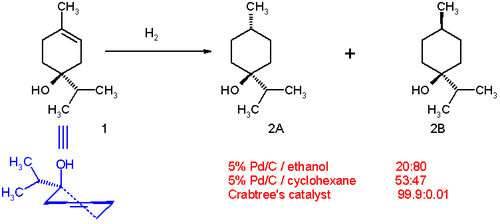- Crabtree's catalyst
-
Crabtree's catalyst 
 (SP-4)tris(cyclohexyl)phosphane
(SP-4)tris(cyclohexyl)phosphane
[(1-2-η:5-6-η)-cycloocta-1,5-diene]
pyridineiridium(1+) hexafluoridophosphate(1−)Identifiers CAS number 64536-78-3 Properties Molecular formula C31H50F6IrNP2 Molar mass 804.9026 g/mol  (verify) (what is:
(verify) (what is:  /
/ ?)
?)
Except where noted otherwise, data are given for materials in their standard state (at 25 °C, 100 kPa)Infobox references Crabtree's catalyst is the name given to a complex of iridium with 1,5-cyclooctadiene, tris-cyclohexylphosphine, and pyridine. It is a homogeneous catalyst for hydrogenation reactions, developed by Robert H. Crabtree, a professor at Yale University. The iridium atom in the complex has a square planar molecular geometry, as expected for a d8 complex.[1][2]
Crabtree and graduate student George Morris discovered this catalyst in the 1970s while working on iridium analogues of Wilkinson's rhodium-based catalyst at the Institut de Chimie des Substances Naturelles at Gif-sur-Yvette, near Paris. One advantage of Crabtree's catalyst is that it is about 100 times more active than Wilkinson's and can hydrogenate even tri- and tetrasubstituted alkenes.
Crabtree's catalyst has also been used as the basis for the development of newer catalysts; by modifying the ligands, one can modulate the properties of the catalyst. For example, use of chiral ligands has led to the development of enantioselective catalysts.
In the hydrogenation of a certain terpen-4-ol the comparison with traditional catalysts works out as follows.[3] With palladium on carbon in ethanol the product distribution is 20:80 in favor of the cis isomer (2B in scheme 1). The polar side (with the hydroxyl group) interacts with the solvent leaving the apolar to the catalyst surface. In cyclohexane as solvent the distribution changes to 53:47 where the polar side now has a slight preference for the catalyst. The distribution changes completely in favor of the cis isomer 2A when Crabtree's catalyst is used in dichloromethane. This directing effect is due to a bonding interaction of the hydroxyl group with the iridium center. Carbonyl groups are also known to direct the hydrogenation by the Crabtree catalyst.
References
- ^ Crabtree, R. H. (1979). "Iridium compounds in catalysis". Acc. Chem. Res 12 (9): 331–337. doi:10.1021/ar50141a005.
- ^ Brown, J. M. (1987). "Directed Homogeneous Hydrogenation". Angew. Chem. Int. Ed. 26 (3): 190–203. doi:10.1002/anie.198701901.
- ^ Crabtree, R.H. Davis, M. W. (1986). "Directing effects in homogeneous hydrogenation with [Ir(cod)(PCy3)(py)]PF6". J. Org. Chem. 51 (14): 2655–2661. doi:10.1021/jo00364a007.
Iridium compounds Categories:- Homogeneous catalysis
- Coordination compounds
- Iridium compounds
- Cod complexes
Wikimedia Foundation. 2010.

